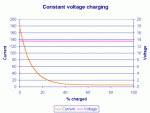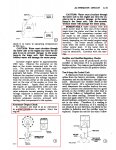Yes, flywheel and magnets all APPEAR to be good anyways. It starts right up and runs perfect, so I am assuming flywheel and magnets are all good.I am only seeing about 12.1 VDC at idle and only gets up to about 12.4 VDC at higher RPM (on water hose at home.) Using multimeter set to AC volts, each yellow wire out of stator only reads about 3.5 V to ground, Between both yellow from stator with motor running I only get about 15VAC at any rpm. I am thinking my replacement stator I bought used is indeed faulty as well??
Wait as tick!!..........15VAC across the yellows? That is a good thing. Don't replace anything yet. That is a RMS measurement, so 15Vrms * 1.414 = 21.21 Vp and after two Si diodes (bridge rectifier) 21.21 Vp - (2*0.6) = 20VDC.
You have an open/reg/rec issue somewhere after those yellow wires still sir!...........Give us a hint man, what cha workn on plz? Can't help much more unless we know this.....
It sure can charge them both, with neglectable other loading (1, 2 amps for engine etc) and given time, see below. HOWEVER, during testing and to expedite this, if they're
both charged up in advance, 6 A still should rise them both back up to 14'ish volts after a bit of time, say within 5/10 minutes max (I say this because given enough time, few days, whatever, or starting with good known charged up batts, even my/a 1.5 A trickle chargers can have 3 flooded lead in parallel to 14.3 volts within the hour, do it all the time but, again
they're topped off as i hook them up)
FYI and FWIW, Any AC voltage measurement referenced to ground (engine block etc) should be invalid on those yellow charge wires due to the stators charge windings are typically floating (I'm not a Jonnyrude guy but, most charge windings are not ground referenced, so the 3.5V isn't real per-se I'd guess) HOWEVER, the 15VAC across the two yellows is valid and is definitely in the ball park....Press on young soldier, you're getting close.

Alternators can be modeled as a constant voltage source, thus they charge with a constant voltage(but do have limited current---real world). OP's would only differ (if his were dis-charged'ish) here in that the voltage would sag at first due to current limiting (6 amps, real world) but, in time, the current draw would decrease to less then the limited 6 amps, the voltage then would have climbed to be around 14V at this point, the current draw then begins to tapper off slowly as time passes to nearly zero amps (see graph).......This is independent of battery capacities (paralleled etc)
























